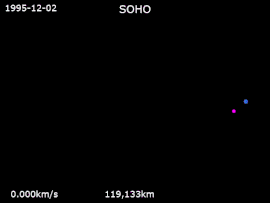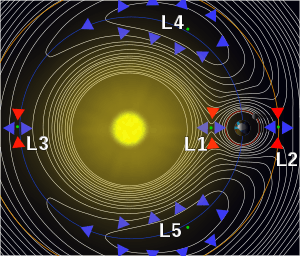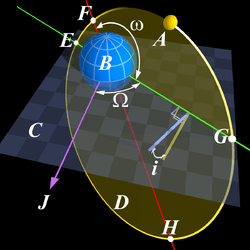Halo orbit
A halo orbit is a periodic, three-dimensional orbit near one of the L1, L2 or L3 Lagrange points in the three-body problem of orbital mechanics. Although a Lagrange point is just a point in empty space, its peculiar characteristic is that it can be orbited. Halo orbits can be thought of as resulting from an interaction between the gravitational pull of the two planetary bodies and the Coriolis and centripetal acceleration on a spacecraft. Halo orbits exist in any three-body system, e.g., the Sun–Earth–Orbiting Satellite system or the Earth–Moon–Orbiting Satellite system. Continuous "families" of both Northern and Southern halo orbits exist at each Lagrange point. Because halo orbits tend to be unstable, stationkeeping is required to keep a satellite on the orbit.


Earth · SOHO

| Part of a series on |
| Astrodynamics |
|---|
 |
|
Orbital parameters |
|
Gravitational influences |
|
Preflight engineering |
|
Efficiency measures |
Most satellites in halo orbit serve scientific purposes, for example as space telescopes.
Definition and history
Robert W. Farquhar first used the name "halo" for these orbits in his 1968 Ph.D. thesis.[1] Farquhar advocated using spacecraft in a particular halo orbit on the far side of the Moon (Earth–Moon L2) as a communications relay station for an Apollo mission to the far side of the Moon. A spacecraft in such a halo orbit would be in continuous view of both the Earth and the far side of the Moon. In the end, no relay satellite was launched for Apollo, since all landings were on the near side of the Moon.[2]
Farquhar used analytical expressions to represent halo orbits; in 1984, Kathleen Howell showed that more precise trajectories could be computed numerically.[3]
The first mission to use a halo orbit was ISEE-3, a joint ESA and NASA spacecraft launched in 1978. It traveled to the Sun–Earth L1 point and remained there for several years. The next mission to use a halo orbit was Solar and Heliospheric Observatory (SOHO), also a joint ESA/NASA mission to study the Sun, which arrived at Sun–Earth L1 in 1996. It used an orbit similar to ISEE-3.[4] Although several other missions since then have traveled to Lagrange points, they typically have used the related non-periodic variations called Lissajous orbits rather than an actual halo orbit.
In May 2018, Farquhar's original idea was finally realized when China placed the first communications relay satellite into a halo orbit around the Earth-Moon L2 point.[5] On 3 January 2019, the Chang'e 4 spacecraft landed in the Von Kármán crater on the far side of the Moon, using the Queqiao relay satellite to communicate with the Earth.[6][7]
See also
- Interplanetary Transport Network
- Lissajous orbit, another Lagrangian-point orbit which generalizes halo orbits.
- Near-rectilinear halo orbit
- Category:Spacecraft using halo orbits
References
- Farquhar, R. W.: "The Control and Use of Libration-Point Satellites", Ph.D. Dissertation, Dept. of Aeronautics and Astronautics, Stanford University, Stanford, California, 1968
- Schmid, P. E. (June 1968). "Lunar Far-Side Communication Satellites" (PDF). NASA. Retrieved 2008-07-16.
- Howell, Kathleen C. (1984). "Three-Dimensional Periodic Halo Orbits". Celestial Mechanics. Volume 32 (1): 53–71.
- Dunham, D.W. and Farquhar, R. W.: "Libration-Point Missions 1978-2000," Libration Point Orbits and Applications, Parador d'Aiguablava, Girona, Spain, June 2002
- Xu, Luyuan (2018-06-15). "How China's lunar relay satellite arrived in its final orbit". The Planetary Society.
This is the first-ever lunar relay satellite at this location.
- Jones, Andrew (2018-12-05). "China to launch Chang'e-4 lunar far side landing mission on December 7". GBTIMES.
- "Chang'e-4 returns first images from lunar farside following historic landing". SpaceNews.com. 2019-01-03. Retrieved 2019-01-08.
External links
- SOHO - The Trip to the L1 Halo Orbit
- Low Energy Interplanetary Transfers Using Halo Orbit Hopping Method with STK/Astrogator
- Gaia's Lissajous Type Orbit — a Lissajous-type orbit, i.e., a near-circular ellipse or "halo"